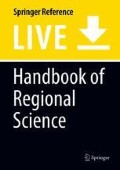Abstract
Generation and diffusion of innovation are two distinct processes that are interlinked in several ways. First, innovation efforts of firms are stimulated by the diffusion of innovation ideas. Second, the market penetration of successful product innovations diffuse to user firms and consumers, providing users opportunities to adopt novel routines and to imitate new designs. Third, creative destruction develops when a novel product finds its way to customers and replaces earlier product vintages, and this phenomenon has the nature of a substitution process. All these processes are supported by knowledge flows which vary in intensity and diversity across the innovation milieu of functional regions. It is concluded that the milieu characteristics which stimulate innovation also stimulate adoption of novelties.
References
Adams JD, Jaffe AB (1996) Bounding the effects of R&D: investigation using matched establishment-firm data. Rand J Econ 27(04):700–721
Aghion P, Howitt P (1992) A model of growth through creative destruction. Econometrica 60(02):323–351
Andersson M, Gråsjö U (2009) Spatial dependence and the representation of space in empirical models. Ann Regional Sci 43(1):159–180
Andersson M, Johansson B (2010) Heterogeneous distributions of firms sustained by innovation dynamics – a model with empirical illustration and analysis. J Ind Compet Trade. https://doi.org/10.1007/s10842-010-0092-z
Andersson M, Johansson B, Karlsson S, Lööf H (2012) Introduction: Innovation and growth – from R&D strategies of innovating firms to economy-wide technological change. In: Andersson M, Johansson B, Karlsson C, Loof H (eds) Innovation and Growth – from R&D strategies of innovating firms to economy-wide technological change. Oxford University Press, Oxford, pp 1–20
Batten DF, Johansson B (1989) Dynamics of product substitution. In: Andersson ÅE, Batten DF, Johansson B, Nijkamp P (eds) Advances in spatial theory and dynamics. North-Holland, Amsterdam, pp 23–44
Beckmann MJ (2000) Interurban knowledge networks. In: Batten D (ed) Learning, innovation and urban evolution. Kluwer, London, pp 127–135
Capello R (2002) Entrepreneurship and spatial externalities: theory and measurement. Ann Reg Sci 36(3):387–402
Coe DT, Helpman E (1995) International R&D spillovers. Eur Econ Rev 39(5):859–887
Cohen WM, Levin RC (1989) Empirical studies of innovation and market structure. In: Schmalensee R, Willig R (eds) Handbook of industrial organization. North-Holland, Amsterdam
Dosi G, Nelson RR (2010) Technical change and industrial dynamics as evolutionary processes. In: Hall BH, Rosenberg N (eds) Economics of innovation. Elsevier, Amsterdam, pp 381–410
Fischer MM, Varga A (2003) Spatial knowledge spillovers and university research. Ann Reg Sci 37(2):303–322
Geroski PA (1998) An applied econometrician’s view of large company performance. Rev Ind Organ 13(3):271–294
Griliches Z (1957) Hybrid corn: an exploration in the economics of technological change. Econometrica 25(4):501–522
Hägerstrand T (1967) Innovation diffusion as a spatial process. The University of Chicago Press, Chicago
Henderson V (1997) Externalities and industrial development. J Urban Econ 42(3):449–470
Jacobs J (1969) The economy of cities. Random House, New York
Johansson B, Quigley J (2004) Agglomeration and networks in spatial economics. Pap Reg Sci 83(1):165–176
Keller W (2004) International technology diffusion. J Econ Lit 42(3):752–782
Klette TJ, Kortum S (2004) Innovating firms and aggregate innovation. J Polit Econ 112(5):986–1018
Mansfield E (1968) The economics of technological change. Norton, New York
Mansfield E (1987) Diffusion of technology. The new Palgrave a dictionary of economics. Palgrave Macmillan, Hampshire, pp 842–844
Nelson RR, Winter SG (1982) An evolutionary theory of economic change, The Belknap Press of Harvard University Press Cambridge, Massachusetts, and London, England
Nyström K (2006) Entry and exit in Swedish industrial sectors. JIBS dissertation series No. 032, Jönköping International Business School
OECD (2005) Oslo manual: guidelines for collecting and interpreting innovation data, 3rd edn. OECD, Paris
Ohlin B (1933) Interregional and international trade. Harvard University Press, Cambridge
Polanyi M (1966) The tacit dimension. Doubleday, New York
Romer PM (1986) Increasing returns and long-run growth. J Polit Econ 94(5):1002–1037
Schumpeter JA (1934) The theory of economic development. Oxford University Press, New York
Teece DJ (2010) Technological innovation and the theory of the firm. In: Hall B, Rosenberg N (eds) Handbook of the economics of innovation. North-Holland, Amsterdam, pp 679–730
Vernon R (1966) International investment and international trade in the product cycle. Q J Econ 80(2):190–207
Von Hippel E (1994) Sticky information and the locus of problem solving: implications for innovation. Manag Sci 40(4):429–439
Wolff EN (1997) Spillovers, linkages and technical change. Econ Syst Res 9(1):9–23
Wolff EN (2012) Spillover, linkages and productivity growth in the US economy, 1958 to 2007. In: Andersson M, Johansson B, Karlsson C, Loof H (eds) Innovation and Growth – from R&D strategies of innovating firms to economy-wide technological change. Oxford University Press, Oxford, pp 233–265
Author information
Authors and Affiliations
Corresponding author
Editor information
Editors and Affiliations
Rights and permissions
Copyright information
© 2019 Springer-Verlag GmbH Germany, part of Springer Nature
About this entry
Cite this entry
Johansson, B. (2019). Generation and Diffusion of Innovation. In: Fischer, M., Nijkamp, P. (eds) Handbook of Regional Science. Springer, Berlin, Heidelberg. https://doi.org/10.1007/978-3-642-36203-3_23-1
Download citation
DOI: https://doi.org/10.1007/978-3-642-36203-3_23-1
Received:
Accepted:
Published:
Publisher Name: Springer, Berlin, Heidelberg
Print ISBN: 978-3-642-36203-3
Online ISBN: 978-3-642-36203-3
eBook Packages: Springer Reference Economics and FinanceReference Module Humanities and Social SciencesReference Module Business, Economics and Social Sciences

